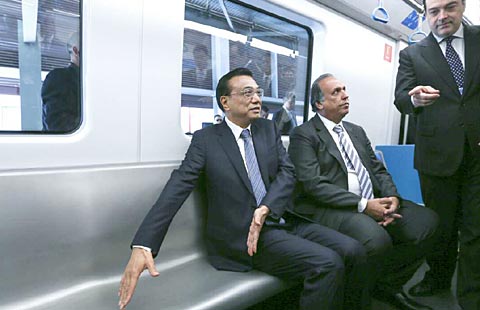China-built water projects generate clean power for Latin America
Updated: 2015-05-23 17:08
(Xinhua)
|
||||||||
 |
|
Employees work in one of the tunnels of the Coca Codo Sinclair hydroelectric project, in El Chaco, Napo province, Ecuador, April 7, 2015. [Photo/Xinhua] |
Two weeks after the completion of the tunnel, Ecuador inaugurated a large flood control and irrigation project built by the Chinese construction company China Gezhouba Group Corporation (CGGC).
The project is designed to avoid floods and droughts affecting coastal cities in the South American country. This is the second mega water project of the 16 projects that the Ecuadorian government plans to build with a total investment of 2,500 million U.S.dollars.
The Ecuadorian authorities said that the project has created 750 jobs and will benefit more than 65,000 people engaged in agriculture and also boost the production of sugarcane in local areas to produce clean fuels like ethanol.
CGGC has strictly followed local environmental laws and regulations and developed appropriate environmental management, testing and emergency handling systems. The company regularly monitors the quality of drinking water, sewage water and generator exhaust.
Moreover, CGGC also regularly sends professional medical teams to treat local residents and distribute medicines.
Since 2011, CGGC has also been responsible for the construction of Sopladora Hydropower Station in Ecuador. The 488MW project, which is still under construction, is very important for Ecuador's economic development and the improvement of people's livelihood.
The two companies, among other reputed Chinese companies, have made progress in Ecuador and also actively tapped the markets of other Latin American countries.
Between 2000 and 2013, trade in goods between China and Latin America and the Caribbean increased from around $12 billion to nearly $270 billion.
China is now a major creditor, investor and trade partner across the Community of Latin American and Caribbean States (CELAC). The Chinese side has proposed to raise the bilateral trade volume to 500 billion dollars and investment in the region to at least 250 billion dollars over the next decade.
The present economic and trade cooperation between the two countries can be aptly and vividly described by an old Chinese maxim, "A bosom friend afar brings a distant land near."
With the substantial advances in modern transportation and communication, the geographical distance between China and Latin America has been greatly reduced. Moreover, tangible benefits and win-win cooperation further reduce the psychological distance between the peoples and increase their desire to know and cooperate with each other.

 Colombia: A birdwatcher's paradise
Colombia: A birdwatcher's paradise
 Journey of a migrant girl from village to ad world
Journey of a migrant girl from village to ad world
 Photographer captures Chinese on the train
Photographer captures Chinese on the train
 Hou Hsiao-Hsien's The Assassin premieres in Cannes
Hou Hsiao-Hsien's The Assassin premieres in Cannes
 Top 10 highest-paid white-collar jobs in China
Top 10 highest-paid white-collar jobs in China
 The dying craft of balance scales
The dying craft of balance scales
 Culture Insider: Six things you may not know about Grain Buds
Culture Insider: Six things you may not know about Grain Buds
 Premier Li rides on new China-made train in Rio de Janeiro
Premier Li rides on new China-made train in Rio de Janeiro
Most Viewed
Editor's Picks

|

|

|

|

|

|
Today's Top News
China, Peru to diversify trade focus
Li: 'Great potential' for Sino-Colombian ties
Green-tea flavored coffee: a simile for cultural ties
Beijing responds to surveillance by US plane
Beijing sets out its rights after reports of incursion
China may have edge in race to build California's bullet train
US Senate votes to move forward fast-track trade legislation
Colombia runs into infrastructure bumps on road to prosperity
US Weekly

|

|







